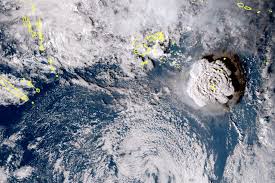A massive underwater volcanic eruption near Tonga on January 15, 2022, sent shockwaves across the Pacific Ocean, triggering tsunami advisories for the U.S. and Canadian West Coast. From California to Alaska, beaches were closed, marinas were flooded, and officials warned people to stay away from the shoreline as powerful waves rolled in.
A Volcano That Shook the World
The Hunga Tonga-Hunga Ha’apai volcano, located about 40 miles north of Tonga’s main island, erupted with an intensity rarely seen in modern history. The explosion sent a towering cloud of ash and gas more than 12 miles into the sky, and the force of the blast was so strong that it was heard as far away as New Zealand and even parts of Australia.
This wasn’t just any eruption—it was a record-breaking event. Scientists say the energy released was equivalent to hundreds of nuclear bombs going off at once. The blast was so powerful that it sent shockwaves around the entire planet, and satellite images captured the eruption’s massive reach.

Tsunami Waves Hit the West Coast
Tsunami waves traveling at nearly 500 mph reached the shores of North America just hours after the eruption. In California, waves surged into harbors and flooded parts of Santa Cruz, damaging boats and piers. In Oregon and Washington, strong currents made the ocean dangerous for swimmers and boaters.
Officials in Berkeley, California, ordered more than 100 people to evacuate from a marina, worried that the rising water levels could put lives in danger. In Northern California, two people were swept into the ocean while fishing but were rescued and survived.
Though the waves weren’t massive—mostly between 1 to 3 feet high—they were powerful enough to cause strong currents and unexpected surges, making the ocean unpredictable and dangerous.
Warnings and Safety Measures
The whole West Coast was promptly under tsunami alerts from the National Weather Service (NWS), which cautioned residents to stay away from low-lying regions, beaches, and harbors. Even tiny waves may be dangerous, authorities said, even if the advisories weren’t full-scale tsunami warnings.
Emergency personnel had to intervene when some individuals continued to approach the water too closely in spite of the warnings. Authorities in several places had to rescue persons who had disregarded the cautions and became entangled in the powerful currents.
How Did a Volcano Create a Tsunami?
We typically think of earthquakes when we think about tsunamis. However, in this instance, a volcanic explosion served as the catalyst. Waves spread forth over the ocean as a result of the tremendous explosion, which instantly displaced a vast volume of water.
In contrast to tsunamis caused by earthquakes, which rise into enormous walls of water, this one distributed energy around the Pacific more like a shockwave. The waves were powerful enough to create hazardous surges along the shore, while not being as tall as those observed in past tsunamis.
Tonga Cut Off From the World
While the tsunami’s impact on North America was relatively minor, Tonga was not as lucky. The eruption blanketed the island nation in thick layers of volcanic ash, contaminating water supplies and damaging homes.
Even more devastating, Tonga’s main internet and phone connection to the outside world was cut off when the undersea communication cable was likely damaged in the blast. With no way to communicate, families around the world were left in the dark, anxiously waiting for news from their loved ones.
A Wake-Up Call for Coastal Communities
The “Ring of Fire,” which is where the Pacific Ocean is located, is prone to earthquakes and volcanic eruptions. People who live close to the shore have already had to deal with the fear of tsunamis, such as the enormous waves caused by the 2011 earthquake in Japan.
This incident serves as a reminder, according to experts, that tsunamis can strike at any moment and occasionally with little notice. Coastal residents are advised by emergency personnel to always be ready, be aware of evacuation routes, and heed tsunami warnings.
A Reminder of Nature’s Unpredictable Power
Luckily, this tsunami didn’t cause widespread devastation on the U.S. West Coast, but it served as a stark reminder of how interconnected our planet is. A volcanic eruption thousands of miles away sent waves crashing onto North American shores in just hours.
Scientists are still studying the eruption’s full impact, but one thing is clear—nature is powerful and unpredictable. Events like this show why early warning systems and emergency preparedness are so important.


Comments are closed, but trackbacks and pingbacks are open.